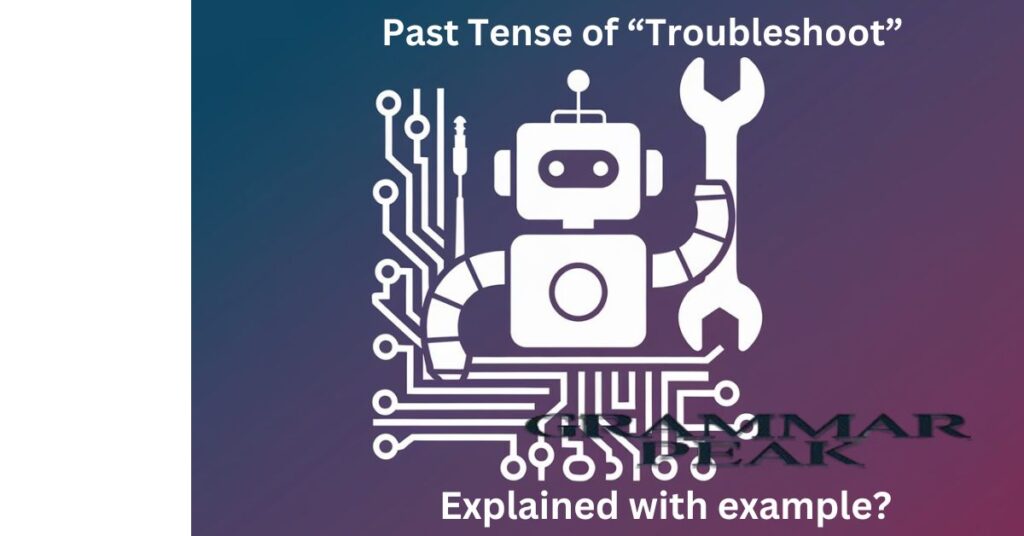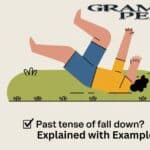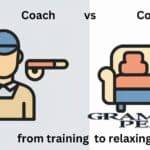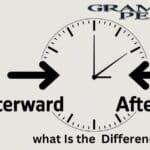Have you ever wondered, what’s the past tense of troubleshoot? This question may seem simple, but it opens up a world of understanding about language. When discussing troubleshooting, we discuss the art of solving problems.
In this article, we will explore the past tense, known as troubleshooted, and how it fits into our daily communication. We will also dive into the distinctions between present and past actions. By the end, you’ll have a clear grasp of this verb conundrum and be ready to use it confidently.
In the Present: Troubleshooting Today
In today’s technology-driven world, the ability to troubleshoot is essential. The term means to identify and resolve issues, particularly with technology. For example, when your computer freezes, you often need to troubleshoot to find the cause. This skill is not just for IT professionals; anyone can learn to troubleshoot effectively.
Troubleshooting is everywhere. From fixing your phone to solving issues with household appliances, it’s a vital part of daily life. A recent survey showed that 70% of people encounter technology problems at least once a week. These moments require effective communication skills and problem-solving abilities.
Example:
Consider the story of Sarah, a graphic designer. One day, her software crashed right before a deadline. Frustrated, she had to troubleshoot the issue.
Sarah quickly checked her computer settings and updated her software. Within minutes, she resolved the problem. This situation illustrates how important troubleshooting is in our lives.
You will like What’s the Past Tense of Troubleshoot?
In the Past: The Journey of “Troubleshooted”
Now let’s shift our focus to the past tense of troubleshoot: troubleshooted. Understanding this form helps us convey past actions. When we say, “I troubleshot the issue yesterday,” we communicate that the action is complete.
The word “troubleshoot” comes from the combination of “trouble” and “shoot.” This blend reflects the idea of shooting down problems. As language evolves, so do verbs. Troubleshooted is an irregular verb form that shows how language changes over time.
Example:
Let’s look at another example. Last week, John encountered a printing problem. He troubleshooted the printer by checking the connections and ink levels.
After a few minutes, he found that the printer was out of ink. In this case, John used his problem-solving skills to identify the issue.
Present vs. Past: Quick Recap
To clarify the differences between the present and past forms, let’s create a quick recap table. This table will help you visualize how these verbs function in sentences.
Examples:
| Present Action | Past Adventure |
| I troubleshoot software bugs. | Last month, I troubleshooted a major bug. |
| He troubleshoots system failures. | A few days ago, he troubleshooted the system crash. |
| They troubleshoot connection problems. | Last night, they troubleshooted the Wi-Fi issue. |
| We troubleshoot user complaints. | Recently, we troubleshooted several user tickets. |
| You troubleshoot hardware issues. | Last week, you troubleshooted a hardware failure. |
Read more about What’s the Past Tense of Troubleshoot?
When to Use Which
Knowing when to use troubleshoot or troubleshooted can be tricky. The rule is simple: use troubleshoot for ongoing or current issues and troubleshooted for completed actions.
Common mistakes often arise in casual conversation. People may say, “I troubleshoot yesterday,” instead of “I troubleshooted yesterday.” Such errors can confuse listeners and impact your grammar.
Examples:
| Present Scenario | Past Happening |
| I troubleshoot problems daily. | Last year, I troubleshooted several complex cases. |
| She typically troubleshoots network issues. | During the last incident, she troubleshooted connectivity problems. |
| We troubleshoot software regularly. | In the previous update, we troubleshooted a critical software error. |
| He often troubleshoots customer queries. | Last week, he troubleshooted multiple customer concerns. |
| You troubleshoot system errors frequently. | In the last meeting, you troubleshooted some key system errors. |
Mastering the Verb Conundrum
Mastering verbs can feel like a language game. It requires practice and attention to detail. For irregular verbs like troubleshoot, understanding the rules is essential.
One effective way to master these verbs is through storytelling. Try to create a story that involves both present and past actions. Doing this makes the learning process engaging and memorable.
Wrapping Up the Time Travel
In our exploration of the past tense of troubleshoot, we’ve navigated through the intricacies of troubleshooting today and how it has evolved. Understanding the verb forms like troubleshooted not only enhances our communication skills but also sharpens our problem-solving abilities.
As we reflect on the present vs. past, it’s clear that mastering these distinctions can significantly improve our language proficiency and grammar skills.
FAQ” S
What is the past tense of troubleshoot?
The past tense of troubleshoot is troubleshooted.
Why is it important to know verb tenses?
Knowing verb tenses helps improve clarity and effectiveness in communication.
How do I use troubleshoot in a sentence?
You can say, “I troubleshoot issues daily.”
Can you give an example of troubleshooted?
Sure! “Yesterday, I troubleshooted my computer problem.”
What if I mix up the tenses?
Mixing up tenses can lead to confusion, so practicing correct usage is essential.
Conclusion
In summary, understanding what’s the past tense of troubleshoot—troubleshooted—is vital for effective communication. Knowing the difference between present and past forms can improve your grammar and overall language skills. Practice using these verbs, and you’ll soon feel confident in your communication.

Mason Blake is an experienced blogger with a passion for language and communication. With years of expertise in crafting informative and engaging content, Mason shares valuable insights on grammar and writing. His clear, concise, and reader-friendly approach has earned him a loyal following, helping readers sharpen their language skills and master the art of effective communication.








Your point of view caught my eye and was very interesting. Thanks. I have a question for you.
I don’t think the title of your article matches the content lol. Just kidding, mainly because I had some doubts after reading the article.
Thanks for sharing. I read many of your blog posts, cool, your blog is very good.
I don’t think the title of your article matches the content lol. Just kidding, mainly because I had some doubts after reading the article.
Can you be more specific about the content of your article? After reading it, I still have some doubts. Hope you can help me. https://www.binance.info/sl/register?ref=PORL8W0Z
Can you be more specific about the content of your article? After reading it, I still have some doubts. Hope you can help me. https://www.binance.info/el/register?ref=IQY5TET4
Can you be more specific about the content of your article? After reading it, I still have some doubts. Hope you can help me.
สำหรับผู้ที่เพิ่งเริ่มต้นและนักเดิมพันมืออาชีพ wy789 ได้สร้างสภาพแวดล้อมที่เหมาะสมที่สุดในการเรียนรู้และฝึกฝนทักษะของคุณ คุณจะได้พบกับเกมที่ออกแบบมาเพื่อให้ผู้เล่นทุกระดับสามารถเข้าถึงได้ พร้อมทั้งมีฟีเจอร์สอนเทคนิคการเล่นและระบบทดลองเล่นฟรีที่ทำให้คุณสามารถเข้าใจเกมก่อนลงทุนจริง การเลือกเล่นกับ WY789 จะทำให้คุณไม่เพียงแค่สนุกกับเกมเท่านั้น แต่ยังสามารถสร้างรายได้เสริมและเพิ่มโอกาสในการทำกำไรได้อย่างต่อเนื่อง ระบบการเงินที่ปลอดภัยและการบริการลูกค้าแบบมืออาชีพทำให้ผู้เล่นทุกคนมั่นใจได้ว่าการลงทุนกับ WY789 เป็นการลงทุนที่คุ้มค่าและน่าเชื่อถือ นี่คือเหตุผลว่าทำไม WY789 จึงเป็นเว็บไซต์ที่นักเดิมพันทั้งใหม่และเก่าต้องไม่พลาด
Thanks for sharing. I read many of your blog posts, cool, your blog is very good.
Your article helped me a lot, is there any more related content? Thanks!